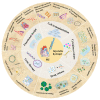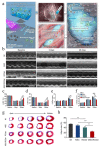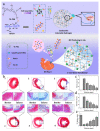Research Advances of Injectable Functional Hydrogel Materials in the Treatment of Myocardial Infarction
- PMID: 35877508
- PMCID: PMC9316750
- DOI: 10.3390/gels8070423
Research Advances of Injectable Functional Hydrogel Materials in the Treatment of Myocardial Infarction
Abstract
Myocardial infarction (MI) has become one of the serious diseases threatening human life and health. However, traditional treatment methods for MI have some limitations, such as irreversible myocardial necrosis and cardiac dysfunction. Fortunately, recent endeavors have shown that hydrogel materials can effectively prevent negative remodeling of the heart and improve the heart function and long-term prognosis of patients with MI due to their good biocompatibility, mechanical properties, and electrical conductivity. Therefore, this review aims to summarize the research progress of injectable hydrogel in the treatment of MI in recent years and to introduce the rational design of injectable hydrogels in myocardial repair. Finally, the potential challenges and perspectives of injectable hydrogel in this field will be discussed, in order to provide theoretical guidance for the development of new and effective treatment strategies for MI.
Keywords: drug; genes; growth factor; hydrogel; myocardial infarction; stem cells.
Conflict of interest statement
The authors declare no conflict of interest.
Figures






Similar articles
-
Biotherapeutic-loaded injectable hydrogels as a synergistic strategy to support myocardial repair after myocardial infarction.J Control Release. 2021 Jul 10;335:216-236. doi: 10.1016/j.jconrel.2021.05.023. Epub 2021 May 20. J Control Release. 2021. PMID: 34022323 Review.
-
Advances in Injectable Hydrogel Strategies for Heart Failure Treatment.Adv Healthc Mater. 2023 Jul;12(19):e2300029. doi: 10.1002/adhm.202300029. Epub 2023 Mar 27. Adv Healthc Mater. 2023. PMID: 36913661 Review.
-
An injectable conductive hydrogel with dual responsive release of rosmarinic acid improves cardiac function and promotes repair after myocardial infarction.Bioact Mater. 2023 Jul 12;29:132-150. doi: 10.1016/j.bioactmat.2023.07.007. eCollection 2023 Nov. Bioact Mater. 2023. PMID: 37621769 Free PMC article.
-
An injectable silk sericin hydrogel promotes cardiac functional recovery after ischemic myocardial infarction.Acta Biomater. 2016 Sep 1;41:210-23. doi: 10.1016/j.actbio.2016.05.039. Epub 2016 Jun 2. Acta Biomater. 2016. PMID: 27262742
-
Hydrogel-based cardiac patches for myocardial infarction therapy: Recent advances and challenges.Mater Today Bio. 2024 Nov 7;29:101331. doi: 10.1016/j.mtbio.2024.101331. eCollection 2024 Dec. Mater Today Bio. 2024. PMID: 39619639 Free PMC article. Review.
Cited by
-
Engineered Vesicles and Hydrogel Technologies for Myocardial Regeneration.Gels. 2023 Oct 18;9(10):824. doi: 10.3390/gels9100824. Gels. 2023. PMID: 37888397 Free PMC article. Review.
-
Interaction of cardiomyocytes from CCND2-overexpressing human induced pluripotent stem cells with electrically conductive hydrogels.RSC Adv. 2025 Jun 24;15(27):21408-21423. doi: 10.1039/d5ra03024b. eCollection 2025 Jun 23. RSC Adv. 2025. PMID: 40556703 Free PMC article.
-
Hydrogels in cardiac tissue engineering: application and challenges.Mol Cell Biochem. 2025 Apr;480(4):2201-2222. doi: 10.1007/s11010-024-05145-3. Epub 2024 Nov 4. Mol Cell Biochem. 2025. PMID: 39495368 Review.
-
Application of Gelatin/Vanillin/Fe3+/AGP-AgNPs Hydrogels Promotes Wound Contraction, Enhances Dermal Growth Factor Expression, and Minimizes Skin Irritation.ACS Omega. 2025 Mar 4;10(10):10530-10545. doi: 10.1021/acsomega.4c10648. eCollection 2025 Mar 18. ACS Omega. 2025. PMID: 40124024 Free PMC article.
-
Milk protein-based hydrogels: Development and biomedical applications.Biomater Transl. 2025 Jun 25;6(2):127-150. doi: 10.12336/bmt.24.00071. eCollection 2025. Biomater Transl. 2025. PMID: 40641996 Free PMC article. Review.
References
-
- Virani S.S., Alonso A., Benjamin E.J., Bittencourt M.S., Callaway C.W., Carson A.P., Chamberlain A.M., Chang A.R., Cheng S., Delling F.N., et al. Heart Disease and Stroke Statistics—2020 Update: A Report from the American Heart Association. Circulation. 2020;141:e139–e596. doi: 10.1161/CIR.0000000000000757. - DOI - PubMed
-
- Jiang J., Guo Y., Huang Z., Zhang Y., Wu D., Liu Y. Adjacent surface trajectory planning of robot-assisted tooth preparation based on augmented reality. Eng. Sci. Technol. Int. J. 2022;27:101001. doi: 10.1016/j.jestch.2021.05.005. - DOI
-
- Gao H., Hsu P.-H., Li K., Zhang J. The Real Effect of Smoking Bans: Evidence from Corporate Innovation. J. Financ. Quant. Anal. 2020;55:387–427. doi: 10.1017/S0022109018001564. - DOI
-
- Antman E., Bassand J.P., Klein W., Ohman M., Lopez Sendon J.L., Rydén L., Simoons M., Tendera M. Myocardial infarction redefined—A consensus document of the Joint European Society of Cardiology American College of Cardiology Committee for the Redefinition of Myocardial Infarction: The Joint European Society of Cardiology/American College of Cardiology Committee. J. Am. Coll. Cardiol. 2001;37:973. - PubMed
Publication types
LinkOut - more resources
Full Text Sources

